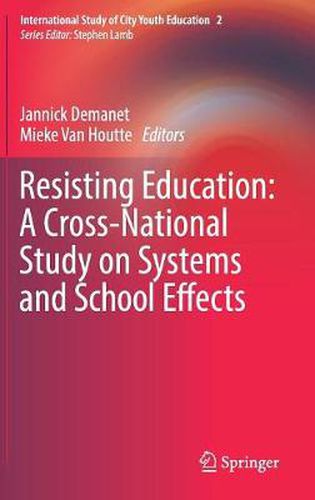Readings Newsletter
Become a Readings Member to make your shopping experience even easier.
Sign in or sign up for free!
You’re not far away from qualifying for FREE standard shipping within Australia
You’ve qualified for FREE standard shipping within Australia
The cart is loading…






This title is printed to order. This book may have been self-published. If so, we cannot guarantee the quality of the content. In the main most books will have gone through the editing process however some may not. We therefore suggest that you be aware of this before ordering this book. If in doubt check either the author or publisher’s details as we are unable to accept any returns unless they are faulty. Please contact us if you have any questions.
This book focuses on how school-level features affect student resistance to education from a comparative angle, taking into account cross-national differences. All over the world, policy makers, school administrators, teachers, and parents are dealing with students who resist education. Resisting school might ultimately lead to unqualified dropout, and it is therefore crucial to understand what triggers resistance in students.
The book uses the ISCY data set to study multilevel questions in detail. It does so based on the view that system effects and school effects intertwine: system-level policy measures affect student outcomes in part by shaping school-level features, and school effects may differ according to certain system-level features. We start from an overarching theoretical framework that ties the various city-specific insights together, and contains empirical studies from Barcelona, Bergen, Ghent, Montreal Reykjavik, Sacramento, and Turku. It shows that, in all countries, the act of resisting school is more likely to occur among the socio-economically disadvantaged, and those in the most disadvantaged schools. However, educational system features, including tracking, free school choice, and school autonomy, are important driving factors of the differences between schools. As such, systems have the tools to curb between-school differences in resistance.
Previous research turns resistance into a problem of individual students. However, if school or system features engender resistance to school, policy initiatives directed at individual students may solve the problem only partially.
$9.00 standard shipping within Australia
FREE standard shipping within Australia for orders over $100.00
Express & International shipping calculated at checkout
This title is printed to order. This book may have been self-published. If so, we cannot guarantee the quality of the content. In the main most books will have gone through the editing process however some may not. We therefore suggest that you be aware of this before ordering this book. If in doubt check either the author or publisher’s details as we are unable to accept any returns unless they are faulty. Please contact us if you have any questions.
This book focuses on how school-level features affect student resistance to education from a comparative angle, taking into account cross-national differences. All over the world, policy makers, school administrators, teachers, and parents are dealing with students who resist education. Resisting school might ultimately lead to unqualified dropout, and it is therefore crucial to understand what triggers resistance in students.
The book uses the ISCY data set to study multilevel questions in detail. It does so based on the view that system effects and school effects intertwine: system-level policy measures affect student outcomes in part by shaping school-level features, and school effects may differ according to certain system-level features. We start from an overarching theoretical framework that ties the various city-specific insights together, and contains empirical studies from Barcelona, Bergen, Ghent, Montreal Reykjavik, Sacramento, and Turku. It shows that, in all countries, the act of resisting school is more likely to occur among the socio-economically disadvantaged, and those in the most disadvantaged schools. However, educational system features, including tracking, free school choice, and school autonomy, are important driving factors of the differences between schools. As such, systems have the tools to curb between-school differences in resistance.
Previous research turns resistance into a problem of individual students. However, if school or system features engender resistance to school, policy initiatives directed at individual students may solve the problem only partially.